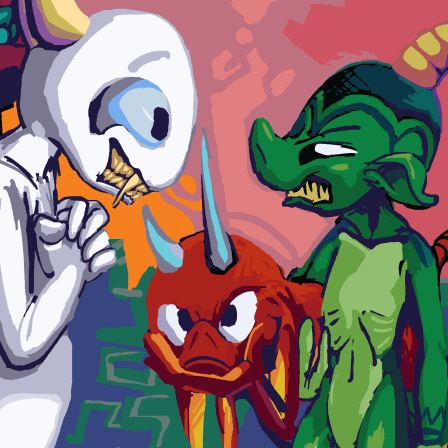
page 40 of this’s redrawings.
I am disappointed that these are not getting any easier even though the base drawings are less incomprehensible overall. There is less figuring for me to do, but just as much redrawing, alas. And still not NO refiguring, since I seem to have kept up cramming in dialog baubles wherever they would fit, and wherever they would not fit long beyond a reasonable time period. Some people can draw a whole comic book in a day, I can barely draw one old page in a month.
However, I have received the proof prints of the first book, all printed and properly bound together for the first time, and it seems like doing that in greater numbers is a viable operation. All this may amount to something, even if not a whole lot.
Minutae:
Somehow, I only noticed after I had redrawn the thing that I never explained, to myself or anyone else, how kumquat has closed the door in the last frame here. The next page certainly does not explain it; kumquat points at a control unit that was clearly not being touched when the door shut. This note is to remind me to shoe-horn in a clumsy retroactive explanation for that next.
Compared to the old version, I had to change the dialog because it was terribly out of character for elpse to not scream at or attack somebody who admitted to hurting nemitz on purpose.
The lizard’s first appearance is also out of character, but since that takes up two rows, it is hard for me at this point to think of something else that should go there. Since I inserted a page before here where elpse gets angry at someone for hurting nemitz who did not even do so, this page is harder to ignore.
Although maybe I would have made more success if I didn’t try to justify everything and just wrote an anarchy story. Nobody ever said to me: I like this comic strip but sometimes the characters have inconsistent personalities. But generally if people don’t like something they just keep quiet so I have to anticipate what they are having a problem with.
One good thing to come of the print attempt that I can apply immediately, is that it forced me to figure out exactly how much space I “have.” A long time ago I measured a comic book that I had and based my space usage on that, not considering that the book I measured might have had a reason for not printing to the page edges. And as I changed the paper I drew on, and its orientation several times, my proportions got further warped. Now I match them to a template provided by Ka-Blam, the print company, which I presume is consistent, at least, with what other north american printers are using.
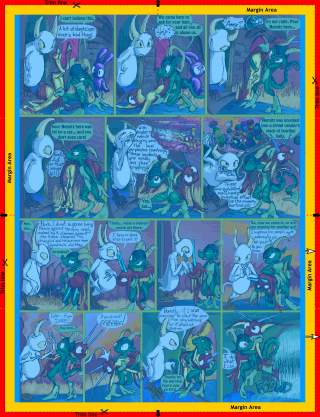
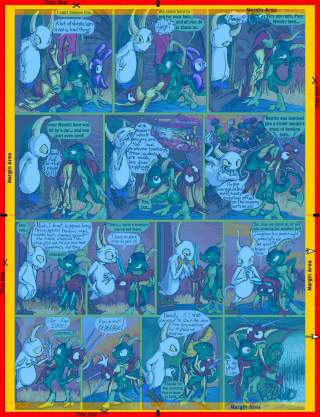
The version I had here for years is either too narrow when scaled to the height of the template, leaving “live” space on the sides, or too tall when scaled to its width, entering the forbidden margin zone. Narrow is actually fine, since extra live space will be filled in exactly the same as the margin space. What is wrong with drawing in the margins? They MIGHT be cut off, due to natural shifting while printing or cutting across many documents. And the bleed WILL be cut off in any event. So why can’t the computer just choose to NOT print into the bleed since it knows exactly where that is? Don’t bother to ask anybody that question, since they will pretend you are asking something else and treat you like you are rubbing a doughnut on your face. They guard this sacred knowledge like it’s the Davinci Code. You just have to live with it, or you die for it.
So I can leave the page narrow. Except I drew way too big originally, and had to cram in the dialog awkwardly around the drawings that I could not comfortably reduce. Therefore, I ought to widen the page, and claim the live space that is rightfully mine to try and declutter the wordage, right? But I had already been widening the redrawn pages based on my latest guess at correct page proportions prior to using the template, which actually ends up being too wide or too short for proper printing!!! I went too far!
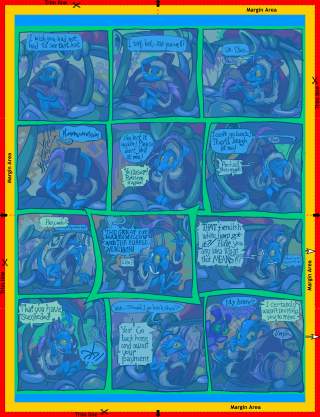
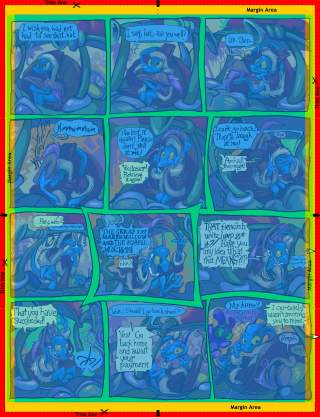
Scandal! Look at all that free live space! I long to see it captured and slaughtered. Having it be marginalized is inadequate punishment.
But too short, like too narrow, can go unnoticed. Since I arranged the words reasonably this time, nothing more needs to be done. In the printed book, therefore, most pages are too short. For once I left things alone! I only talled up a few toward the end of the process, and superficially altered a few others immediately prior to printing by increasing the size of the gaps between frames.
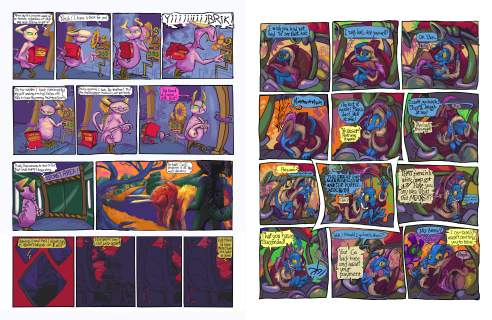
One of the taller pages with enhanced gaps beside one of the shortest, that you may already be acquainted with. The disparity is already not great, and since they do not actually appear together,

and a real book doesn’t lie flat, the issue is almost invisible.
Does that all make sense? It shouldn’t! Printing technology is still stuck in the 1940s. We can electronically send a sandwich into space but we can’t know exactly how a computer image is going to show up on paper right in front of us, and the machine responsible may break in one of many ways trying to do it. It took me so many years and so much rage to figure all this out and get used to it, I have no CHOICE but to keep printing books. For once I know everything that can go wrong and have prepared for them all. The books came out perfectly and I succeeded. I can not be held up further!
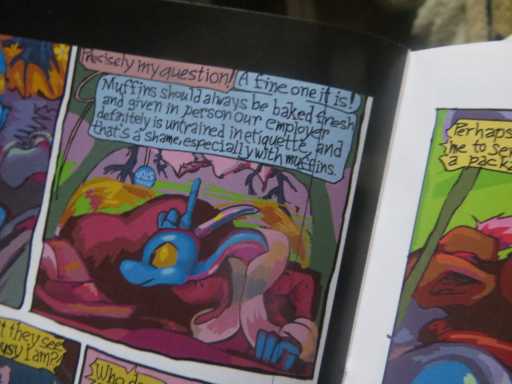
ARRRRRRRRRRRRRRRRRRRRRRRRRGGHHHHFFFFFH I’VE BEEN BORDER-LINED
RSS feed for comments, for they hunger.
This here`s me trackback!
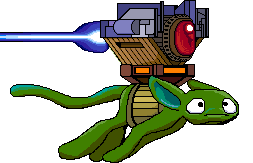
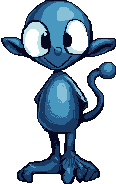
Prescription Pudding Pinged With:
[…] frame to explain how the door shut without kumquat being near it like I said I ought to at the previous pertinent posting, and by the time I thought of it I was inclined to leave it as it was and just give an excuse. […]